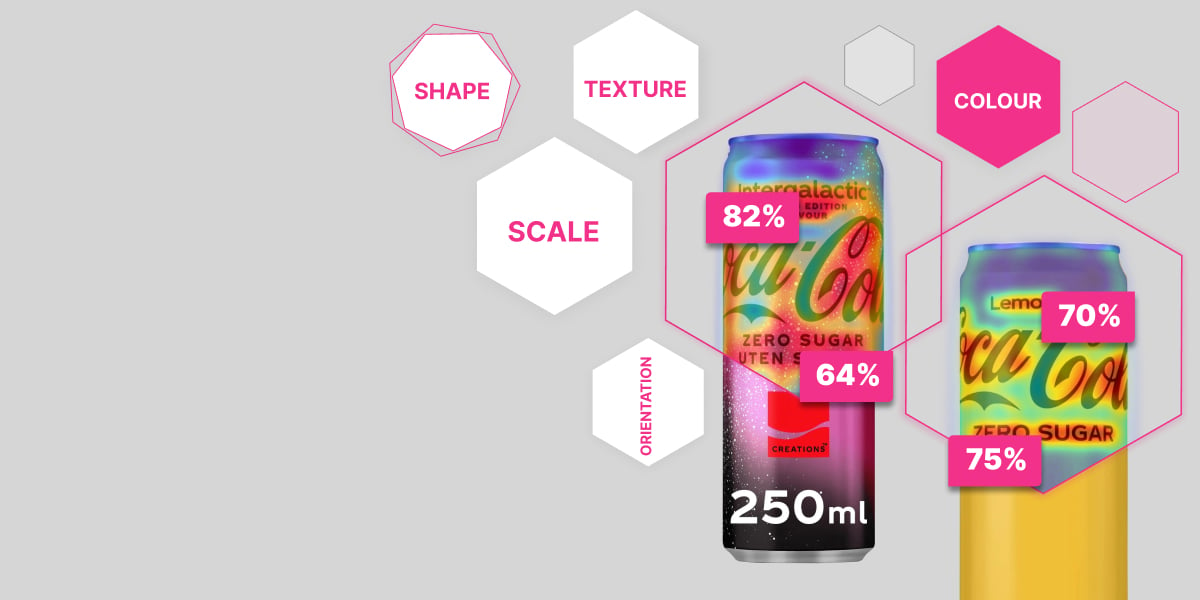The greatest asset any company can have is insights about its customers. Whether you are a global conglomerate or a brand-new start-up. The more you know, the better you can position your brand.
Consumer buying behavior often shapes how companies strategize across their marketing channels. This is why so many resources have been poured into understanding consumers, and the process that drives their decisions.
In this blog, we'll explore how attention is changing the traditional consumer journey and how an attention-driven funnel can help marketers better understand and engage their audience.
Traditional Consumer Journey
Most marketers understand the consumer buying behavior stages and use this understanding to craft effective content. The stages are:
The buying process can’t start without the consumer knowing what they need or want. Marketers often aim to meet this need.
Now the consumer has identified their need, they start actively looking for the best solution. This can include influence from promotional/marketing materials, as well as recommendations and social proof.
Once the consumer has done their research, they consider their options. They make sure they’re taking the most informed pathway before making a final commitment.
The consumer’s purchase intent is clear and validated by their own due diligence, they are ready to own the product. Of course, supply, availability, shipping time, shipping costs, etc. can still disrupt this stage. But ultimately, they are ready to purchase and make payment.
Attention's Role in the Purchase Journey
So where does attention come into this tried and tested traditional journey?
How can marketers tap into those first few seconds of unintentional visual attention that consumers aren’t fully aware of?
Of course, you can match the importance of attention to all of the consumer buying stages in theory. But one of the key stages that attention plays a crucial role is the information search stage when the consumer is reviewing multiple brands to determine which brand fits their needs.
Consider this example: You have a new baby and you need diapers, there are countless brands and you peruse the web and stores to figure out which to buy. So which of these two main brands, Pampers or Huggies, is likely to catch your share of attention?
Here, we are assuming each brand wants to highlight its brand name, logo and value for money (quantity).
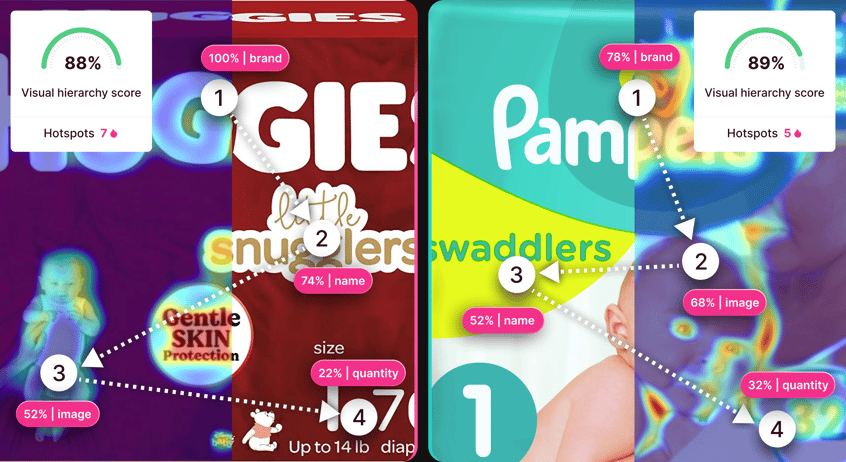
Instantly side by side you can see that Huggies grabs the larger share of attention by 6%, that’s not a small difference between competitors.
- The share of attention is close across the key areas of interest
- Huggies' name has a great probability of perception
- Pampers could optimize across the board for a greater predicted attention
Action Points:
- Pampers could potentially boost performance by increasing attention on the baby, the name of the product, and the brand name
- Huggies could benefit from an all-around optimization with gaze path and visual hierarchy in mind to land their desired messaging effectively. Having said that their name performs really well here.
The Attention-Based Approach to Consumer Buying Behavior
This brings you, quite succinctly, to the new take on consumer buying behavior. The approach is based on the marketing funnel and the experience you'd like your consumers to take from initial awareness through to purchase.
Attention as a central thought to consumer behavior gives you a bit more depth to the understanding of why decisions are made the way that is. You all know that attracting attention is a key part of brand success but here we can break that down in a much clearer way;
Awareness
You want to attract consumers at this point of the journey by maximizing your share of attention in competitive environments.
This can be done by ensuring creative quality across visual content such as advertisements, packaging, banner ads, and more.
So for example: if you are the Shopper Insights Manager for The Hershey Company, and you’d like to know how Hershey products are standing out on Walmart’s digital shelf;
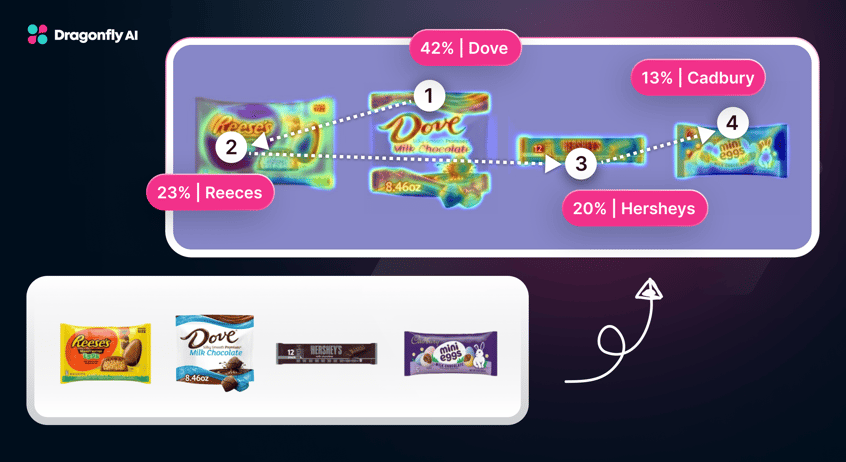
You run predictive analytics on the digital shelf for consumer mapping purposes and learn the following (imagining that you are aligned with the supermarket’s key priorities);
- Walmart's digital shelf as seen here shows us that the largest share of attention lands on Dove with 42%
- The lowest probability of perception is on Cadburys in this instance
- There are no areas of interest depicted for this analysis so this is very much 'what you see is what you get
Action point:
- As consumers are scrolling through what is on offer you can see how fierce the competition is just between these four chocolate options. The action here would be to run more pack testing to ensure attention on the digital shelf exceeds competitors.
- The difference in probability of perception between Dove and Cadburys is substantial, overall digital shelf insights could prove invaluable for the retailer.
Consideration
Next up on the attention-focused consumer experience journey is consideration.
This is where you want to inform your consumers. You’d like them to engage with your key messaging on your visual content. Optimizing visual hierarchy to ensure messaging lands is a great utilization of resources at this point in the buying journey.
You know what you’d like your product to communicate and you have an ideal visual hierarchy, here it can be efficiently matched so that the good stuff you’re wanting to say, is heard.
Now, you are the Senior Brand Manager at Revlon, specifically for Elizabeth Arden. You have new advanced light ceramide capsules to shout about and you want to make the right noise. How do you validate your creative decisions?
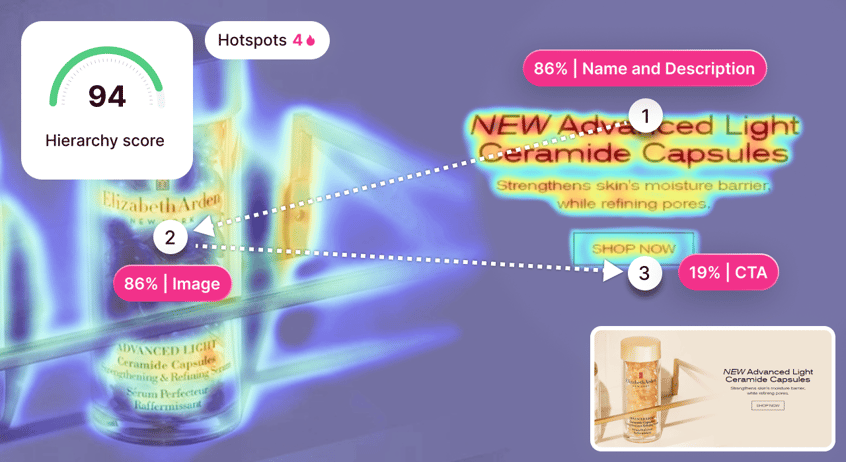
Looking specifically at the ad (which we will pretend is still in the proofing stage), how would you decide whether it was ready to launch (you are of course aware of all the KPIs for the product and know what you are trying to achieve with this ad)?
Consumers are at the point where they are considering options, they’re seeking information about which brand they should commit to.
When you run creative testing, you can see whether the messaging matches the planned visual hierarchy.
- In this ad, the messaging is the first thing people see but the share of attention could be greater, particularly on the CTA.
- The brand name does not stand out and neither does the description. We would recommend optimizing these for better reach.
- When you are launching a campaign you want high impact, low cost. Using predictive analytics at the consideration point of the attention journey will ensure that your brand is winning the highest share of attention at the right time.
Conversion
This is what you are all working towards. Whether it’s along the traditional approach or attention driven, you all want them to make a commitment and convert.
The goal is clear and the method is simple, highlighting calls-to-action so that conversion rates are as good as can be. The conversion stage is where the purchase decision happens. You want to shine a spotlight on the action point so that attention is where it needs to be at this final point of decision-making.
Imagine your role as the Marketing Director for Ariel, one of Procter & Gamble’s leading brands. You’re working to make the website more useful and engaging. Whilst it isn’t a monetary conversion, it is part of a wider nurture plan that is integral to Ariel’s success as a brand. Is the action point as clear as possible?
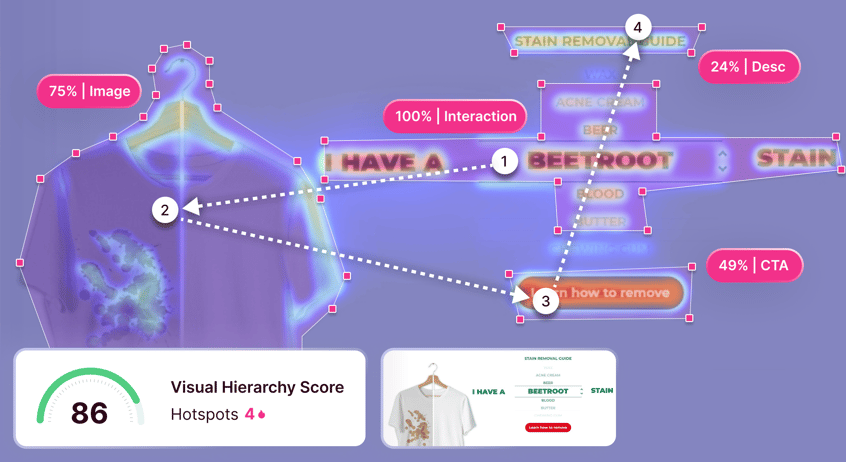
You’re at the conversion stage and you have created this clever interactive call to action. It includes a roll of potential stains and then gives a direct call to action. You know what Ariel wants to achieve and with this in mind, you run the analysis.
Where can this be improved upon?
- The description doesn't have a great probability of perception, neither does the call to action. Ideally with such a fantastic interactive tool the call to action would garner a much higher share of attention.
- Given that this is the conversion stage of the funnel your decision-making needs to be focused on maximizing the share of attention for action.
Increase Sales with an Attention Focused Consumer Journey
You’ve done some good work here. Refreshed your knowledge of the standard consumer buying behavior stages and took a massive jump into the attention-based journey that moved through the marketing funnel.
The attention model is basically a condensed version and ensures attention remains the priority at every step because, without consumer attention, you’re just a tumbleweed.
So, if you’d like to really take control of the consumer buying behavior journey you need to start making attention to the most important person at the strategy table. This is really easy to do when you have the tools to test your creative and predict attention.
Speak to us to hear more about making your consumer journey attention-focused.






